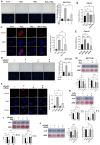ROS-induced PADI2 downregulation accelerates cellular senescence via the stimulation of SASP production and NFκB activation
- PMID: 35218410
- PMCID: PMC8882118
- DOI: 10.1007/s00018-022-04186-5
ROS-induced PADI2 downregulation accelerates cellular senescence via the stimulation of SASP production and NFκB activation
Abstract
Cellular senescence is closely related to tissue aging including bone. Bone homeostasis is maintained by the tight balance between bone-forming osteoblasts and bone-resorbing osteoclasts, but it undergoes deregulation with age, causing age-associated osteoporosis, a main cause of which is osteoblast dysfunction. Oxidative stress caused by the accumulation of reactive oxygen species (ROS) in bone tissues with aging can accelerate osteoblast senescence and dysfunction. However, the regulatory mechanism that controls the ROS-induced senescence of osteoblasts is poorly understood. Here, we identified Peptidyl arginine deiminase 2 (PADI2), a post-translational modifying enzyme, as a regulator of ROS-accelerated senescence of osteoblasts via RNA-sequencing and further functional validations. PADI2 downregulation by treatment with H2O2 or its siRNA promoted cellular senescence and suppressed osteoblast differentiation. CCL2, 5, and 7 known as the elements of the senescence-associated secretory phenotype (SASP) which is a secretome including proinflammatory cytokines and chemokines emitted by senescent cells and a representative feature of senescence, were upregulated by H2O2 treatment or Padi2 knockdown. Furthermore, blocking these SASP factors with neutralizing antibodies or siRNAs alleviated the senescence and dysfunction of osteoblasts induced by H2O2 treatment or Padi2 knockdown. The elevated production of these SASP factors was mediated by the activation of NFκB signaling pathway. The inhibition of NFκB using the pharmacological inhibitor or siRNA effectively relieved H2O2 treatment- or Padi2 knockdown-induced senescence and osteoblast dysfunction. Together, our study for the first time uncover the role of PADI2 in ROS-accelerated cellular senescence of osteoblasts and provide new mechanistic and therapeutic insights into excessive ROS-promoted cellular senescence and aging-related bone diseases.
Keywords: NFκB; Osteoblast; Peptidyl arginine deiminase 2; Reactive oxygen species; Senescence; Senescence-associated secretory phenotype.
© 2022. The Author(s).
Conflict of interest statement
The authors declare that they have no conflicts of interest.
Figures






Similar articles
-
Downregulation of Bach1 protects osteoblasts against hydrogen peroxide-induced oxidative damage in vitro by enhancing the activation of Nrf2/ARE signaling.Chem Biol Interact. 2019 Aug 25;309:108706. doi: 10.1016/j.cbi.2019.06.019. Epub 2019 Jun 11. Chem Biol Interact. 2019. PMID: 31194955
-
The canonical NF-κB pathway differentially protects normal and human tumor cells from ROS-induced DNA damage.Cell Signal. 2012 Nov;24(11):2007-23. doi: 10.1016/j.cellsig.2012.06.010. Epub 2012 Jun 29. Cell Signal. 2012. PMID: 22750558 Free PMC article.
-
Autolysosomal degradation of cytosolic chromatin fragments antagonizes oxidative stress-induced senescence.J Biol Chem. 2020 Apr 3;295(14):4451-4463. doi: 10.1074/jbc.RA119.010734. Epub 2020 Feb 11. J Biol Chem. 2020. PMID: 32047109 Free PMC article.
-
Therapy-induced senescence through the redox lens.Redox Biol. 2024 Aug;74:103228. doi: 10.1016/j.redox.2024.103228. Epub 2024 Jun 6. Redox Biol. 2024. PMID: 38865902 Free PMC article. Review.
-
Keeping the senescence secretome under control: Molecular reins on the senescence-associated secretory phenotype.Exp Gerontol. 2016 Sep;82:39-49. doi: 10.1016/j.exger.2016.05.010. Epub 2016 May 25. Exp Gerontol. 2016. PMID: 27235851 Review.
Cited by
-
Wen-Shen-Tong-Luo-Zhi-Tong Decoction alleviates bone loss in aged mice by suppressing LONP1-mediated macrophage senescence.Pharm Biol. 2025 Dec;63(1):524-548. doi: 10.1080/13880209.2025.2537125. Epub 2025 Jul 28. Pharm Biol. 2025. PMID: 40719285 Free PMC article.
-
Peptidylarginine deiminase 2 plays a key role in osteogenesis by enhancing RUNX2 stability through citrullination.Cell Death Dis. 2023 Aug 30;14(8):576. doi: 10.1038/s41419-023-06101-7. Cell Death Dis. 2023. PMID: 37648716 Free PMC article.
-
Targeting cellular senescence in senile osteoporosis: therapeutic potential of traditional Chinese medicine.Front Med (Lausanne). 2023 Nov 24;10:1288993. doi: 10.3389/fmed.2023.1288993. eCollection 2023. Front Med (Lausanne). 2023. PMID: 38076228 Free PMC article. Review.
-
Nicotinamide enhances osteoblast differentiation through activation of the mitochondrial antioxidant defense system.Exp Mol Med. 2023 Jul;55(7):1531-1543. doi: 10.1038/s12276-023-01041-w. Epub 2023 Jul 18. Exp Mol Med. 2023. PMID: 37464093 Free PMC article.
-
NIPSNAP1 directs dual mechanisms to restrain senescence in cancer cells.J Transl Med. 2023 Jun 20;21(1):401. doi: 10.1186/s12967-023-04232-1. J Transl Med. 2023. PMID: 37340421 Free PMC article.
References
MeSH terms
Substances
Grants and funding
LinkOut - more resources
Full Text Sources

